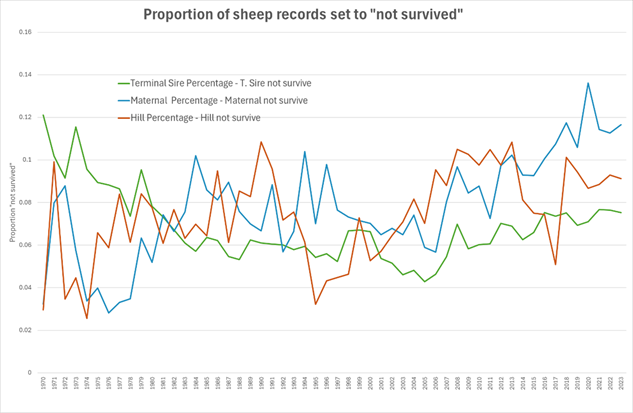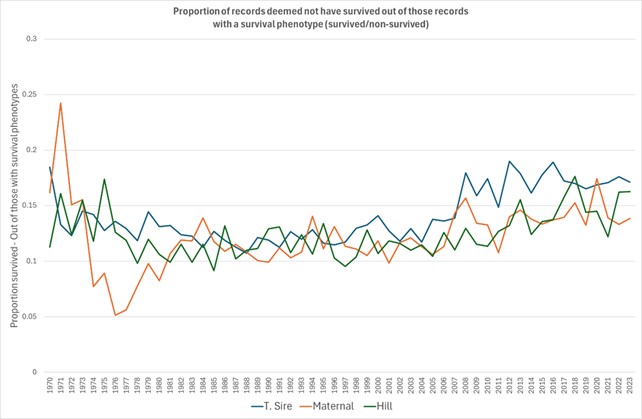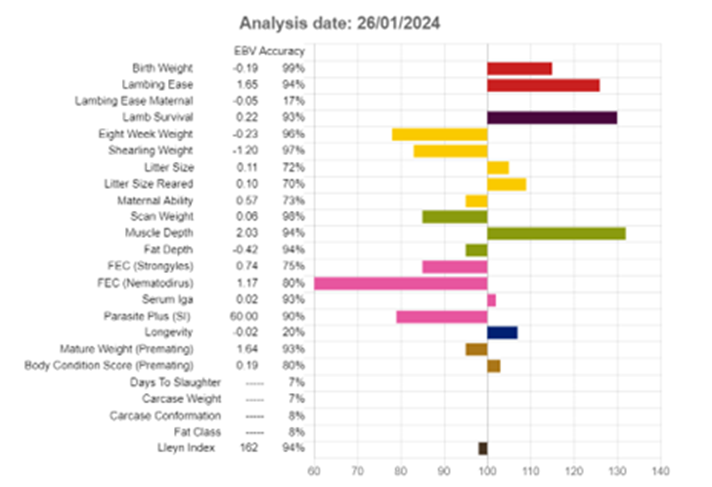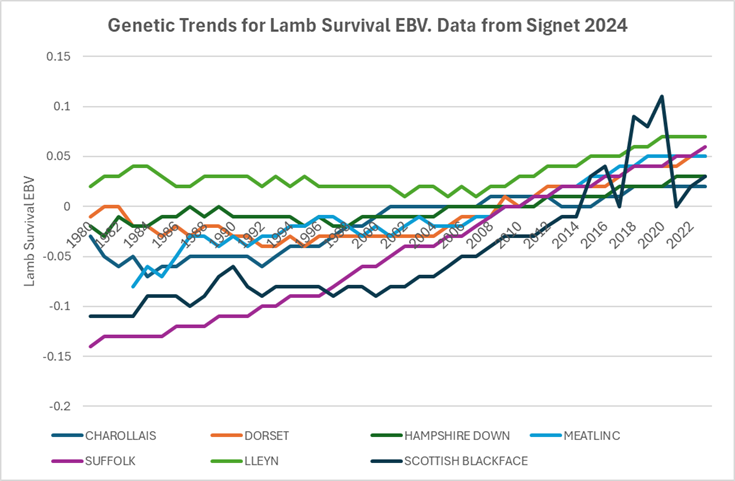Lamb Survival – A trait of economic and environmental importance
Samuel Boon, AHDB/Signet Breeding Services and Samir Id-Lahoucine, SRUC - March 2024.
In the excitement of selecting sires to improve lamb carcase attributes or the maternal performance of their daughters, we occasionally forget our priority as ram breeders is to ensure that rams produce live lambs which survive to the point of sale.
Many factors effect lamb survival, some are influenced by the environment the lamb is born into, some are influenced by the ewe’s maternal performance (whether she has enough milk and leads the lamb to shelter in wet weather). However, the lamb’s own genes also have a marked impact on their future, with commercial farmers needing sires whose progeny are born easily, are fast to their feet and thrive.
As part of the genetic evaluation service provided by Signet we can identify the best breeding lines for lamb survival; highlighting those sires whose lambs thrive and survive – whether you are selecting a hill, maternal or terminal sire.
Recording Lamb Survival
Lamb survival is a binary trait. A lamb is either deemed to have survived or not survived, though in some cases the phenotype is set to “missing” within the analysis, because the trait hasn’t been recorded in a manner to correctly assess survival – for example the flock has 100% survival.
To be deemed to have survived at least one of the following measures must be recorded for the animal
• Early Age Weight
• Twenty One Week weight
• Adjusted Weight
• Muscle Depth
• Fat Depth
• CT Fat Weight
• CT Muscularity
• In the future we may consider adding abattoir traits.
Data edits when assessing lamb survival
Records are analysed within flock-year contemporary groups, comparing the survivability of lambs born within a particular year in the particular flock. Animals from flock-year groups where the percentage of dead lambs is under 5% or over 50% of the lamb crop are assigned an “unknown” phenotype and the data is removed from the analysis.
Survival records are also set to unknown where:-
- Animals (sires and dams) have progeny, but no traits recorded
- Number of records by flock-year<20
- Within the flock/year contemporary group >75% of the records for lambs that didn’t survive are attributed to an unknown sire.
This last factor is important in flocks using DNA parentage assignment, where the lambs that are surviving are being genotyped, but in some flocks many (or all) of the lambs that are lost are not. This distorts the picture of lamb survival in a flock, as sires tend to appear to have high lamb survival simply because the lambs they have which die have not been correctly attributed to them. Data validations are now removing survival data for flocks where this is occurring.
Genetic parameters
The heritability of lamb survival is lower than growth and carcase traits, which means less of the variation that we see in this trait is due to the animals’ genetics compared to these other performance traits. However, lamb survival has a high economic value and is well worth inclusion in our breeding programmes due to its impact on profitability – and also the carbon footprint of the national sheep flock.
Recent research at SRUC has produced following heritability estimates that are used in our evaluations.
|
Launched |
Included in indexes |
Genetic Variance |
Residual Variance |
Heritability |
|
|
Hill evaluation |
2021 |
Yes |
0.015 |
0.089 |
0.144 |
|
Lowland maternal evaluation |
2017 |
Not yet |
0.014 |
0.094 |
0.130 |
|
Terminal Sire evaluation |
2024 |
Not yet |
0.014 |
0.094 |
0.130 |
The effects included in the model are:
- heterosis
- recombination
- litter size born
- dam age
- flock-season contemporary groups
Making use of historic data to assess lamb survival
The three genetic evaluations produced by Signet contain over 4 million animal records. The breakdown of survival phenotypes is as follows, with large numbers set to unknown where data is for non-recorded sources and it is not possible to derive survival data as the animals are not in a flock with weighed/unweighed animals.
Just over half of the animals in Signet’s analyses are currently assigned a survival record.
|
|
Unknown |
Survived |
Did not survive |
Proportion of records unknown |
Proportion of records survived |
Proportion of records did not survive |
Proportion survived* |
|
Term’ Sire |
1326782 |
963067 |
155911 |
54.2% |
39.4% |
6.4% |
86.1% |
|
Maternal |
274911 |
557190 |
84067 |
30.0% |
60.8% |
9.2% |
86.9% |
|
Hill |
353971 |
506080 |
69465 |
38.1% |
54.4% |
7.5% |
87.9% |
* The proportion that survived, out of the number with a survival phenotyped (i.e. ignoring those records set to unknown.
Changes in phenotypic records over time
The proportion of records set to “not survived” and the proportion of sheep deemed not to have survived out of those with a phenotype remain fairly static over time. Any increases reported in lambs not surviving are probably due to more diligent recording of dead lambs in recent years, rather than an increase in mortality.


Publishing Breeding Values
Breeding values are now published on the Signet website for all major breeds.
Example of breeding chart for Lleyn stock ram, INCHEOCH JUPITER

Correlations to other traits
Signet doesn’t fit correlations to other traits within our evaluations, though breeding values are currently produced for lambing ease (direct and maternal) and birth weight. It is logical that flocks wishing to enhance lamb survival should also select for breeding lines that are easy lambing and have an optimal birth weight.
Variation within the trait
Considerable genetic variation appears to exist within breeds. Within the Charollais breed for example, a difference in EBV of 0.12 between the Bottom 10% and Top 10% sires, indicates that potential to increase the number of lambs successfully reared by 6%, though in reality environmental conditions may mask some of these benefits.
Breed Benchmark for 2024
|
Bottom 10% |
Bottom 25% |
Breed Average |
Top 25% |
Top 10% |
|
|
CHAROLLAIS |
-0.03 |
0 |
0.03 |
0.06 |
0.09 |
|
DORSET |
-0.04 |
0 |
0.05 |
0.1 |
0.14 |
|
HAMPSHIRE DOWN |
-0.02 |
0 |
0.03 |
0.06 |
0.08 |
|
MEATLINC |
-0.03 |
0.01 |
0.05 |
0.09 |
0.13 |
|
SUFFOLK |
0 |
0.02 |
0.05 |
0.08 |
0.1 |
|
LLEYN |
-0.02 |
0.02 |
0.07 |
0.12 |
0.16 |
|
SCOTTISH BLACKFACE |
-0.13 |
-0.08 |
-0.03 |
0.02 |
0.07 |
How do we know how many lambs we were expecting?
Many extensive hill flocks use genomic information to determine parentage and lambing events are not closely monitored, dead lambs can be missed, removed by predators or are not recorded. In this scenario pregnancy records can be used to determine the expected number of live lambs, though not the sire of those lambs.
We have used pregnancy scanning records to determine the expected litter size (and thus the number of dead lambs) in our hill sheep evaluation since 2020.
The challenge of genomics
Genomic approaches have many advantages, not least in providing a correct way to capture parentage. However, where dead lambs are not being genotyped it is common for flocks to lose valuable survival data, as only the surviving animals are being assigned parentage and amongst contemporaries with full parentage, the flock appears to have 100% survival. Data from these flocks is not used in the analysis.
Progress over time
Interestingly the trends for lamb survival over time tend to be positive, despite the absence of a breeding value to aid selection until recent years. This improvement may be arising for several reasons. Flocks are tending to be tested sheep under increasingly commercial conditions, with more ram produced in later lambing flocks that are using more forage in the diet. There is also an upward increase in the breeding values for birth weight, which may be aiding lamb survival.
Selection for easier lambing doesn’t appear to be playing a role in enhancing lamb survival, as in many UK breeds ease of lambing appears to have reduced over time.

Summary
- Lamb survival is an important trait both for economic, welfare and environmental reasons.
- AHDB/Signet can use historic data to assess this trait and important genetic differences are being observed between rams in the expected survival of their progeny.
- Genetic trends for lamb survival tend to show a small increase in survival over time.
- Breeders should make every effort to fully record data on live and dead lambs (including pregnancy scanning data if it is available) as well as including the provision of a weight for every live lamb in the flock at 8 weeks of age.
Further reading
Please note this work builds on AHDB funded research
- Generating estimated breeding values for postnatal lamb survival by Joanne Conington, Kirsty Moore, Cathy Dwyer, Alison Glasgow (2012).
- Generating estimated breeding values for postnatal lamb survival. Report prepared for EBLEX by Ann McLaren, Sebastian Mucha, Kirsty Moore, Joanne Conington (2015)